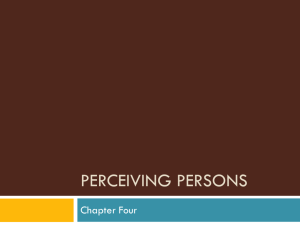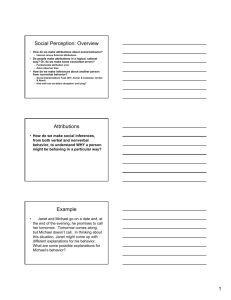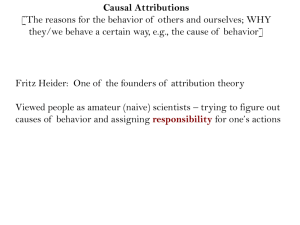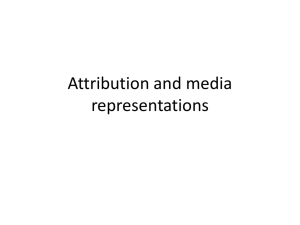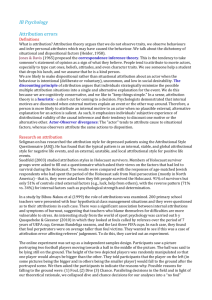Social Perception Slides
advertisement
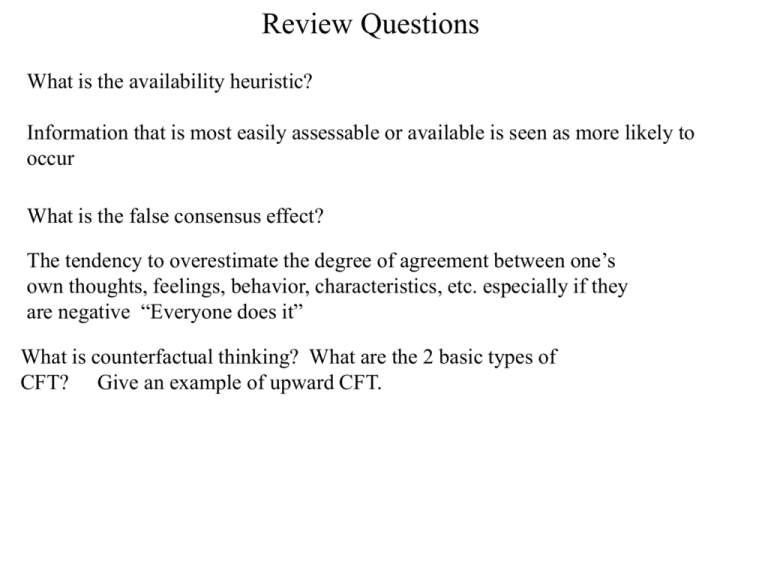
Review Questions What is the availability heuristic? Information that is most easily assessable or available is seen as more likely to occur What is the false consensus effect? The tendency to overestimate the degree of agreement between one’s own thoughts, feelings, behavior, characteristics, etc. especially if they are negative “Everyone does it” What is counterfactual thinking? What are the 2 basic types of CFT? Give an example of upward CFT. The six major (universal) emotional expressions * • Anger • Fear •Happiness • Sadness • Surprise • Disgust What two emotions are hard to distinguish? Non-Verbal Communication * 1) Emblems: Gestures that have specific meanings within a given culture (e.g., “OK” sign) Japan = $; Mexico = sex; Ethiopia = homosexuality; Brazil = “flipping the bird” Thumbs up sign: US = OK; Europe = Excellent; Japan = boyfriend; Iran & Sardinia = obscene 2) Illustrators: Gestures that emphasize a point 3) Affect displays: Basic emotional expressions (e.g., sad, happy) 4) Regulators: Gestures that help to foster communication (e.g., opening mouth to indicate one wants to speak, nodding head in agreement, raising eyebrows to indicate interest) 5) Adaptors: Nonverbal behavior (often habitual) that occur under stressful situations (e.g., twirling hair, tapping fingers) Non-Verbal Communication (cont.) Eye contact: Length of gaze (too little, just right, too much) Cultural Differences Personal space: • Relationship to the other person • Cultural differences • Status differences (high status = more personal space) Touching: • Cultural differences • Gender Differences • Status differences Some Cultural Differences Eye Contact: In US it is valued (e.g., he/she “did not look me in the eye”) = hiding something Nigeria, Puerto, Thailand: Children taught to not make eye contact with superiors (e.g., teachers, adults) Some American Indian tribes: Minimal eye contact Japanese: Overall less eye contact Arabs: Lots of eye contact – approaching a gaze Personal Space and Touching: “High contact” countries = Middle East, South America, Southern Europe Low = US, Northern Europe, Asia, Pakistan Korea, Other parts of Asia, and Egypt = Same sex hold hands Causal Attributions [The reasons for the behavior of others and ourselves; WHY they/we behave a certain way, e.g., the cause of behavior] Fritz Heider: One of the founders of attribution theory Viewed people as amateur (naive) scientists – trying to figure out causes of behavior and assigning responsibility for one’s actions Role of Implicit Personality Theory to make attributions regarding behavior of others Behavior of Others Implicit Personality Uncaring, Cheap Theory [collection of Selfish beliers. assumptions, Warm schemas] about what Nice, Polite traits go together Old Irritable, Inflexible Causal Attributions Stable Unstable Internal External Ability, Intelligence, Personality Traits Task difficulty Effort, Mood Luck, Transitory weather conditions Also, there are 2 other dimensions: Global versus Specific Relationship-Enhancing and Distress-Maintaining Attributions Relationship-Enhancing Attribution Distress-Maintaining Attribution Positive Event My partner takes me out to an expensive dinner My partner is sweet and thoughtful My partner took me out to write the cost off on taxes Internal, stable, global External, unstable, specific Something unexpected must have come up My partner is always uncaring and selfish External, unstable, specific Internal, stable, global Negative Event My partner forgot my birthday Kelly’s Cube (Covariation) Model of Attribution Behavior to be explained: Boss yells at his employee, Hannah (Consistency) How the actor (e.g., boss) behaves toward the same stimulus over time and circumstances/situations Yells at her regularly (Distinctiveness) How the actor (e.g., boss) behaves toward other stimuli (e.g., other people) Hannah Yells at her when store is empty Yells at her when store is full Employee-1 (Sam) Employee-2 (Jamal) Boss Mgr. Coworker (Consensus) How others (e.g., those at work) behave toward the stimuli (e.g., Hannah) Some Cube Theory Examples: * The boss yells at Hannah virtually every time he sees her (High Consistency) No one else yells at Hannah, only the boss (Low Consensus) The boss yells at everyone (Low Distinctiveness) Internal/Trait Attribution. For instance, there is something about the boss – he is mean; an angry person The boss yells at Hannah virtually every time he sees her (High Consistency) Everyone yells at Hannah, not just the boss (High Consensus) The boss only yells at Hannah, not at any other employee (High Distinctiveness) External attribution: There is something about Hannah (e.g., poor worker, she’s difficult to work with) Kelly’s Cube Model of Attribution (cont.) Typically, we do not have complete information about people on all three of Kelly’s dimensions. Also, research has shown that the dimension of “consistency” is used quite a bit, whereas “consensus” is not used frequently. Fundamental Attribution Error * [Correspondent Bias -- that one’s behavior corresponds to one’s personality] The tendency to overemphasize internal explanations for the behavior of others, while failing to consider the power of the situation. Example – • Participants had NO choice in reading a Pro Fidel Castro speech • Others still believe the position reflected that of the person Self-Generated Reality Are people unknowing architects of their own social reality? Responder Inducer Often our role in affecting other’s responses is ambiguous (e.g., personality, physical appearance, social role/position, mannerisms) At other times, we intentionally try to get people to do or say something (e.g., sign petition, donate money, Inducer asks responder to respond a certain way (e.g., 16/20 times in a politically liberal or conservative manner) Later, asked inducers to judge the “real” opinions of the responders --- they made dispositional attributions for the responder’s behavior (i.e., either liberal or conservative politically) Fundamental Attribution Error * Role of Perceptual Salience [what we see or pay attention to, visually obvious] Observers thought that the actor they could see better had a greater impact on the conversation Culture and the Fundamental Attribution Error (or Correspondence Bias) People from individualistic and collectivistic cultures both demonstrate the correspondence bias. Members of collectivist cultures are more sensitive to situational causes of behavior and more likely to rely on situational explanations, as long as situational variables are salient. Less likely to commit fundamental attribution error Actor-Observer Effect (Difference) (Fundamental Attribution Error not applied equally) The actor/observer effect: The tendency to see other people’s behavior as dispositionally caused (e.g., ability, personality), while focusing more on the role of situational factors (e.g., task difficulty, bad luck) when explaining one’s own behavior. Reasons for the Actor-Observer Difference * • Perceptual salience: Actors notice the situations around them that influence them to act, while observers notice the actors Observer’s focus is on the actor Actor’s focus is on the task Information access: Actors have more information about themselves than do observers (e.g., how consistent present behavior is to past behavior) Actor: “That’s the first free throw I’ve missed in 4 games” • Self-Serving (defensive) attributions: Motivated to explain one’s successes by using internal, dispositional factors, as opposed to failures, which are explained by situational factors (e.g., bad luck). Self-serving = Self-esteem maintenance Self-presentation concerns: Look good in the eyes of others Self-Serving/Defensive Attributions and the Just World Hypothesis * • A form of self-serving/defensive attribution is to believe that bad things happen only to bad people or only to people who make stupid mistakes or poor choices. Basic assumption: People get what they deserve and deserve what they get Some negative aspects of the belief in a just world: Victims of crimes, accidents, or poverty can be seen as causing their own fate Battered wives may be seen as responsible for their husbands’ actions ~ Reversing Actors’ and Observers’ Perspectives ~ Actor Observer Observer Other Actor sees own behavior as situational. Observer sees actor’s behavior as dispositional (trait). Actor-observer effect Actor sees self Other (person actor was talking to) Actor sees own behavior as more dispositional. Observer sees actor’s behavior as more situational Quiz Show Game Study (Power of social roles) Questioner (writes a set of 10 reasonably difficult questions Contestant (has to answer the questions by the questioner) Told that this assignment was random; it wasn’t Observers Ratings of others on a general knowledge rest • Questioner perceived as more knowledgeable by contestants and observers GPA and External Attributions for Failure Increasing Retention Rates * Training session to address issues facing new student, How to cope with Problems, Where to go for help, etc. Giving students realistic reasons for possible poor 1st year performance (e.g., new setting, more adjustments, harder classes) • Higher GPA • Less absenteeism • Lower dropout rate • Greater satisfaction with school Attributions in the Sports Pages Overview • Success is attributed to internal factors (Self-Enhancement Strategy ) • Failure is attributed to external factors (Self-Protective Device) • Prevalence of internal outcomes for both success and failure (especially unstable ones) • Unexpected outcomes lead to a greater number of attributions (e.g., need for greater attributional searching for possible explanations) Attribution Examples in Sports Self-Attributions Internal & Unstable (most common in sports for failures) • "I could not be as aggressive as I wanted to be and kind of flinched a couple of times" -- Golfer Ernie Els on a wrist injury and his 77 final round score "For this fight I had to lose a lot of weight. I wasn't that strong … “ --- Boxer Floyd Mayweather on beating Jr. Jesus Chavez • “It was one of those nights. I felt like I couldn’t miss” – Michael Jordan Self-Handicapping Behavior * Early assumptions: A) People wish to have accurate information/feedback regarding their abilities B) Role of achievement motivation (high versus low) Motivation for self-handicapping strategies; behaviors that: A) Enhance external attributions for failure B) Allow internal attributions for success (e.g., Kelly’s augmentation principle) Self-Handicapping Behavior (cont.) "Cause" of self-handicapping A) Non-contingent reinforcement history, especially for success (e.g., Success not due to one’s ability or effort) B) Perception that successful performance cannot likely be repeated Key: The belief that one deserves or has partially earned their success (e.g., due to themselves) has to exist Self-Handicapping Behavior (cont.) Insolvable Task-2 (stakes raised) Insolvable Task “Success” Private Public Drug Choice Ability attributions Males Females Males attributed their “success” to ability more than females Enhancing drug Impairing drug Males much more likely to choose impairing drug – even when only they were told of their initial success (private condition) Seligman’s Suggestions A) Allow external attributions for failure (when reasonable) B) Develop strategies for improvement after failure C) Failure is not “the end of the world” (learning experience, feedback) D) Allow development of personal control in early years of life Misattribution and Speech Anxiety Placebo usage --- a) Cause of one’s arousal is not obvious b) Misattribution source is salient (obvious, easily observable) c) Misattribution source is perceived as plausible Giving a speech (anxiety arousing event) Subliminal noise to increase anxiety Less mistakes made during speech Subliminal noise to decrease anxiety Accurate information; e.g., it’s common to be anxious • Anxiety is partially explained by the noise as well as the person Motivation: SDT (Self-Determination Theory) Extrinsic Motivation The gains we make from the activity motivate us (e.g., money, power, prestige, endorsements) Intrinsic Motivation The activity itself is rewarding; you are interested, and enjoy doing it A Look at Rewards for Motivation * • Good jump ropers during recess were chosen and put in three conditions • Following the intervention, which group will jump rope during recess more? Expected reward: Unexpected reward: Control / No reward: Students were told if they did a good job, they would get a “good jumper” badge. All got a badge. Students were awarded a “good jumper” badge after doing a good job on the task. All got a badge. Students jumped rope, but were not told of a reward, and were not given one. Top Salaries of Athletes in the United States Intrinsic Motivation (“Traditional Belief ”) Overall Motivation = Internal + External Rewards Individuals who intrinsically enjoy their work Why? Increase extrinsic (external) rewards (e.g., pay) Intrinsic Motivation Extrinsic Motivation Can lead to lowered intrinsic motivation • Extrinsic (external) factors now partially account for why individuals are motivated to perform a given task • External rewards limit people’s sense of self-determination Tangible extrinsic rewards reliably undermine intrinsic motivation under most circumstances. The most detrimental reward contingency involves giving rewards as a direct function of people's performance. This is the one most often used in life, and it seems to be the one that is most detrimental to the motivation, performance, and well-being. http://www.psych.rochester.edu/SDT/cont_reward.html Spotlight Effect What is the “Spotlight Effect”: Perception of our behavior as “sticking out” Others will attend to and notice our behavior as being different (an outlier) Lonely Guy Restaurant Scene Overestimating Failure/Harshness Studies 3 scenarios with social blunders --• Setting of library alarm • Forgot to bring gift at party • Seen with cheap store bag Scenario Actors’ prediction Ratings (predictions) provided by: Self (actors) Observers Observers rating 1. Library incident 4.78 3.01 2. Empty-handed guest 5.26 2.47 3. Spotted at the mall 3.31 1.13 On average, actors believe they will be rated MUCH harsher that they are!

